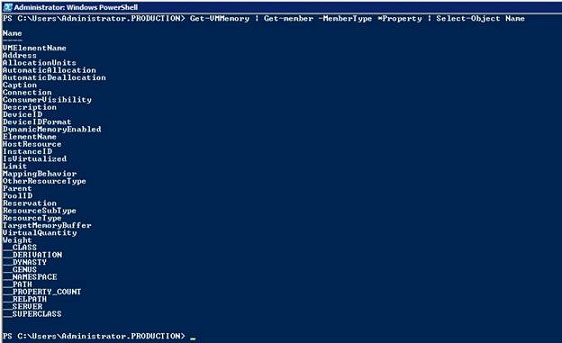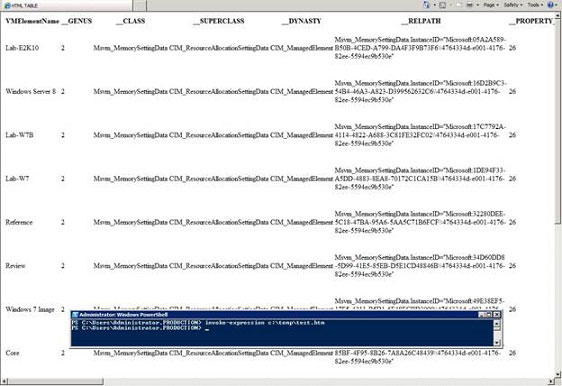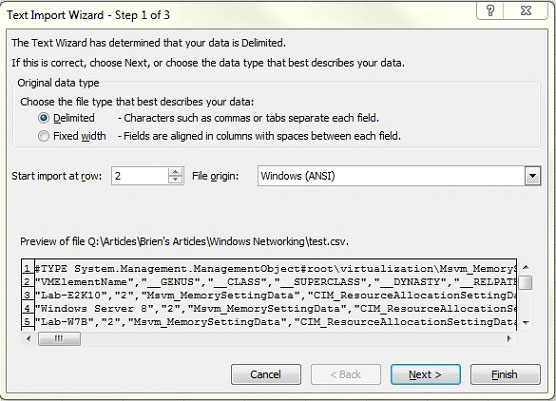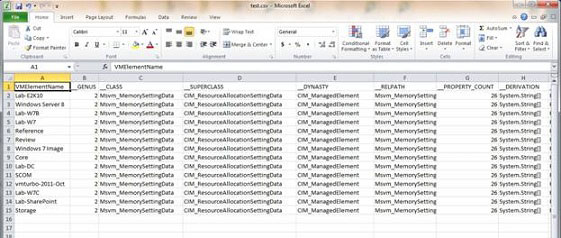Monitor Hyper-V with the command line (Part 4)
TipsMake.com - Among the hardware resources that are usually assigned to virtual machines, perhaps the memory is most fixed. This tutorial will show you how to manage virtual machine memory through Windows PowerShell.
Before starting, remember to enter the Hyper-V monitoring library into PowerShell each time you use Hyper-V related commands. The library entry statement is:
Import-Module 'C: Program FilesModulesHypervHyperv.psd1'
The full commands to download and install the Hyper-V monitoring library are presented in Part 1 of this article series.
Create a memory usage report
Because memory resources are finite, it is important to determine the amount of memory allocated to virtual machines. While this is relatively simple to implement from Hyper-V, this monitor does not have a reporting function. Fortunately, users can still build their own memory usage performance reports directly from Windows PowerShell.
The command is used to check the size of memory a virtual machine is using is Get-VMMemory. The command syntax is as follows:
Get-VMMemory - MF '
In theory, '-Server' is the required parameter, but if this parameter is omitted, the Get-VMMemory command will query the local server by default. Often the user will specify a certain server but can also specify multiple servers. If the query to multiple servers runs Hyper-V, we must enter all the names of the servers. Wildcard doesn't work here.
The virtual machine name parameter is different. This parameter is not catch. If you omit the virtual machine name, PowerShell will display the memory allocation status for all virtual machines on the specified server. If you want to shorten the list range, specify one or more virtual machines.
If only the Get-VMMemory command is entered without the parameter attached, the command will display the memory allocation status for each virtual machine in the local server.

As you can see in the figure, the command lists the virtual memory size, limit, and reserved memory for each virtual machine.
Although it is very handy to be able to see virtual memory size, limit and reserve memory for each virtual machine, you can actually use Get-VMMemory to get more memory related information. half. To do this, we will need to know the names of the attributes supported by the Get-VMMemory cmdlet.
To see a list of all available properties, enter the following statement:
Get-VMMemory | Get-Member –MemberType * Property | Select-Object Name

As shown above, VirtualQuantity, Limit and Reservation are among the listed properties, but there are many other properties. You can use the Get-VMMemory command to display any attribute set. Suppose when you want to see VMElementName, Address and AllocationUnits, enter the following statement:
Get-VMMemory | FT VMElementName, Address, AllocationUnits

Create a memory report
If you want to save memory information for later use, there is a solution to export the Get-Memory cmdlet output into an HTML file.
Use the following statement:
Get-VMMemory | ConvertTo-HTML | Out-File C: tempTest.HTM
As shown below, this statement does not show the output. That's because the command output is being redirected into an HTML file named C: temptest.htm. You can use Windows Explorer to allocate and open files, but you can also open files without leaving PowerShell. Just enter the following command:

Invoke-Expression C: temptest.htm
If you look at the figure below, we will see that this command launches Internet Explorer and displays the HTML file we created. Furthermore, reports in HTML format look a lot different than the report above, although both commands use Get-VMMemory without any extra parameters. In fact, if you look at the bottom of the report screen, you will see a scroll bar indicating that more data is displayed.

This information can be useful to create a CSV file that can be viewed with Excel as a table in Excel rather than as a Web page. Fortunately, PowerShell also has this capability. The command that we will use to accomplish this is similar to the command used to create an HTML report. However here, instead of using HTML ConvertTo, we are using ConvertTo-CSV. The full statement is:
Get-VMMemory | ConvertTo-CSV | Out-File C: temptest.csv
After the CSV file is created, you can double-click the file to open it in Excel. However, it will not display the correct information. To get complete and accurate information, open Excel first, then open the file. Excel will launch the Text Import Wizard. Set up the Wizard to start importing files with Row 2 and perform data separation as shown below.

Next, set the comma-separated data option. Then click on Finish . Data will be entered as shown below.

So, you know how to get data about the virtual machine memory situation from PowerShell. In the next article, we will learn how to change the memory allocated for these machines.
You should read it
- How to rename Hyper-V virtual machines using PowerShell and Hyper-V Manager
- How to import Hyper-V virtual machines in Windows 10
- How to export Hyper-V virtual machines in Windows 10
- Create virtual machines with Hyper-V on Windows 8 and Windows 10
- Monitor Hyper-V with the command line (Part 3): Check virtual machine status
- Create virtual machines in Hyper-V on Windows Server 2008
- How to install Hyper-V in Windows Server 2012
- Instructions for installing Hyper-V
May be interested
- Forget the GUI, the Command Line is returning
 managing windows to the cloud also means a command line revival with powershell and bash.
managing windows to the cloud also means a command line revival with powershell and bash. - How to Disable or Remove Hyper-V on Windows 11
 fortunately, you can disable hyper-v in windows 11 with the help of the classic windows features dialog, command prompt, and powershell.
fortunately, you can disable hyper-v in windows 11 with the help of the classic windows features dialog, command prompt, and powershell. - 5 reasons why people love the Linux command line
 many people are afraid of the command line. they see it as something for software developers or geeks. but the command line is merely another way of interacting with a pc, and there are some tasks that are very easy to do with the cli.
many people are afraid of the command line. they see it as something for software developers or geeks. but the command line is merely another way of interacting with a pc, and there are some tasks that are very easy to do with the cli. - 5 best command line emulation software for Windows 10
 currently, users can get a shell within windows 10, but many still prefer the more configurable command line emulator applications. so this article will introduce you to five of the best command line emulation software for windows 10.
currently, users can get a shell within windows 10, but many still prefer the more configurable command line emulator applications. so this article will introduce you to five of the best command line emulation software for windows 10. - Configure IIS 7 from the command line using Appcmd.exe - Part 1
 this series will introduce how to use the iis 7.0 command line called appcmd.exe to query objects on the web server and display the output as text or xml.
this series will introduce how to use the iis 7.0 command line called appcmd.exe to query objects on the web server and display the output as text or xml. - How to use the Linux command line on Android with Termux
 android is a very operating system 'capacity with more and more desktop accessibility applications. however, sometimes you want to make some things on android that can be as easy as desktop. fortunately, you can use the termux tool, which builds on the existing infrastructure and provides a command line environment that allows you to install real linux applications on your android device.
android is a very operating system 'capacity with more and more desktop accessibility applications. however, sometimes you want to make some things on android that can be as easy as desktop. fortunately, you can use the termux tool, which builds on the existing infrastructure and provides a command line environment that allows you to install real linux applications on your android device. - How to create a command line program in Python with Click
 click is a python package to write command line interfaces with as little code as possible. this article will show you how to use click to create the command line program.
click is a python package to write command line interfaces with as little code as possible. this article will show you how to use click to create the command line program. - 10 tips for using Command Line Windows 10 users should know
 you can use the cmd command to perform some tasks that normally only use mouse, drag and click. the cmd command is also quite useful when you need to create scripts and automated tasks.
you can use the cmd command to perform some tasks that normally only use mouse, drag and click. the cmd command is also quite useful when you need to create scripts and automated tasks. - How to use the htop command to monitor system processes in real time
 the htop command in linux is a command line utility that allows users to monitor important system processes in real time.
the htop command in linux is a command line utility that allows users to monitor important system processes in real time. - Installing and configuring Exchange 2007 from the command line utility - Part 3
 in this article, i will show you how to configure an exchange server for a server by focusing on the mailbox role.
in this article, i will show you how to configure an exchange server for a server by focusing on the mailbox role.










 10 new features in Windows Server 2012
10 new features in Windows Server 2012 Build your own simple NAS system for storage needs
Build your own simple NAS system for storage needs Build your own simple NAS system: Part 2: Installation
Build your own simple NAS system: Part 2: Installation Build your own simple NAS system, part 3: Basic storage configuration
Build your own simple NAS system, part 3: Basic storage configuration Yahoo! attacked, no damage
Yahoo! attacked, no damage Originally Sony server system was hacked
Originally Sony server system was hacked